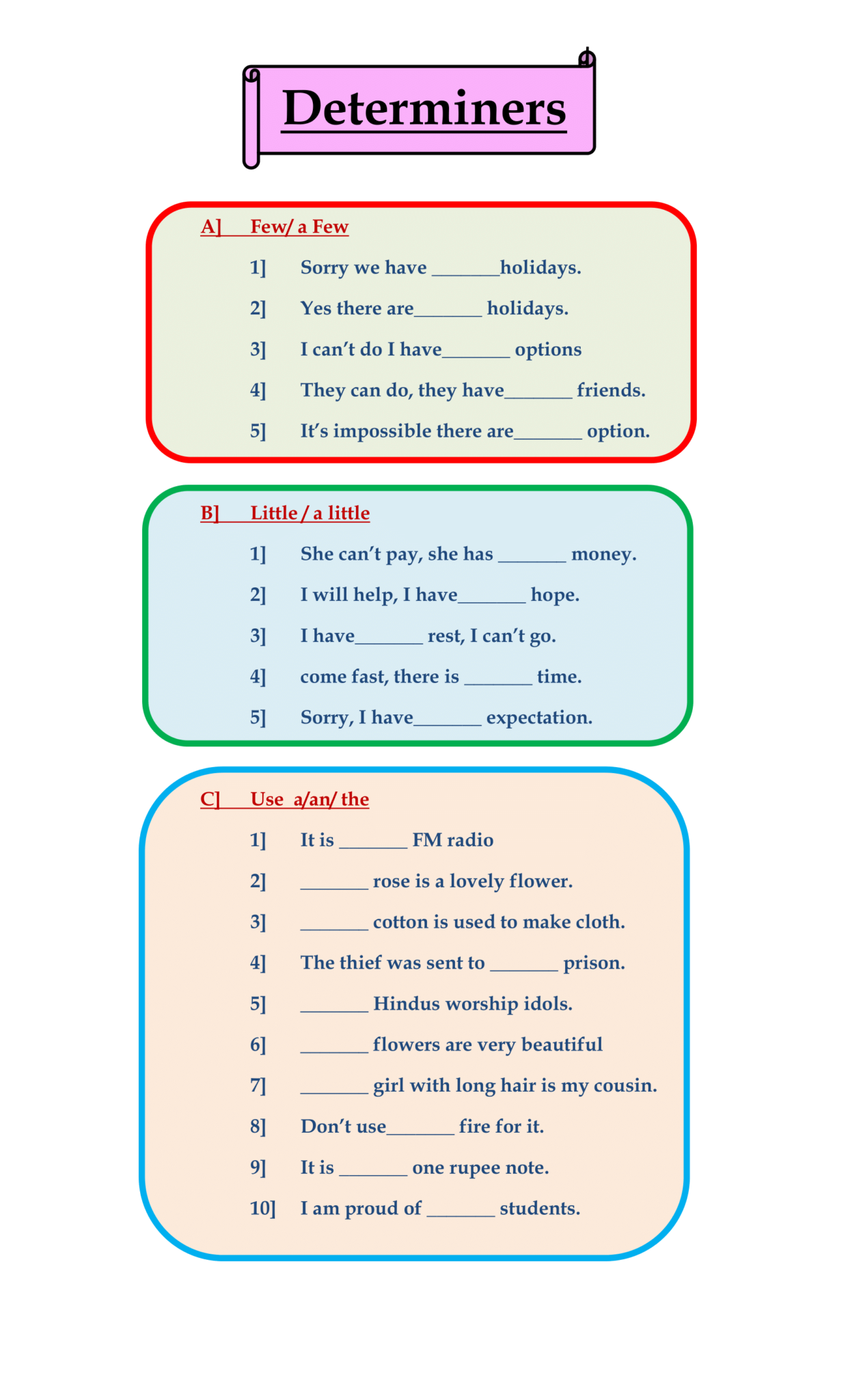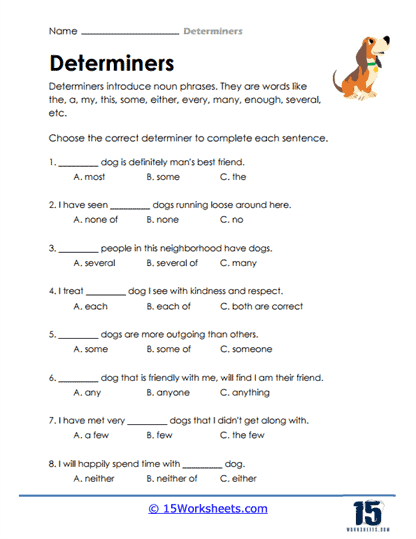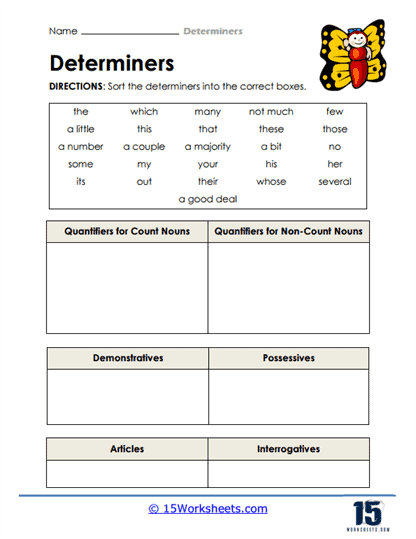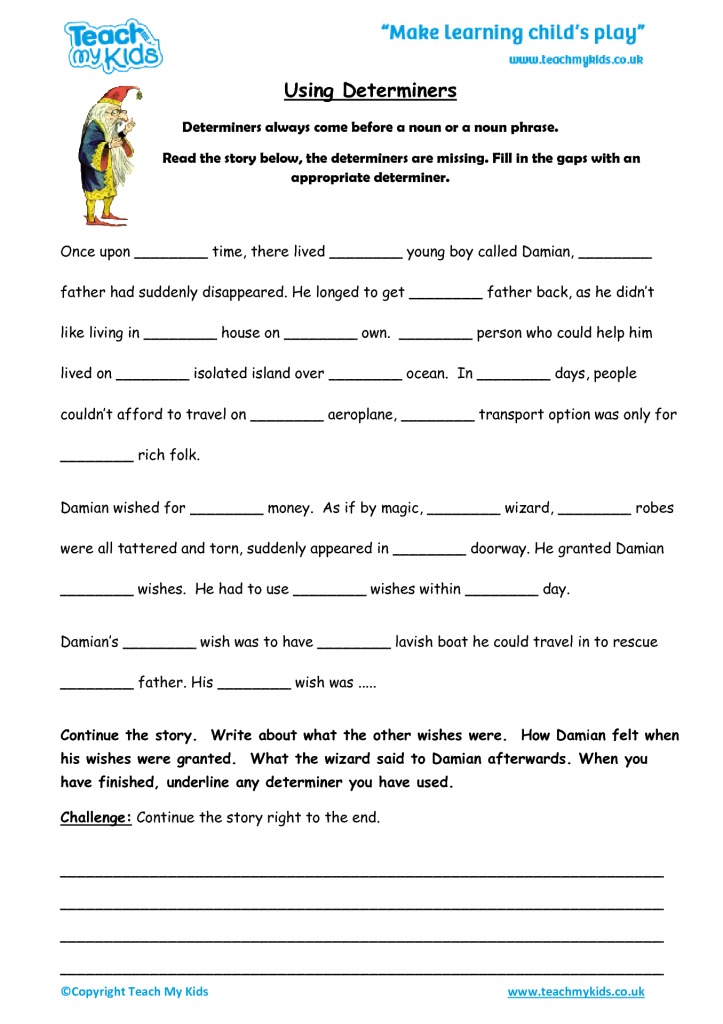
Mastering Clarity: The Essential Role of Grammar Worksheets: Determiners in English Language Learning
English grammar can often feel like a labyrinth, with intricate rules and subtle nuances that challenge even the most dedicated learners. Among the many grammatical components, determiners stand out as small but mighty words that play a pivotal role in shaping the clarity and precision of our communication. They are the gatekeepers of nouns, providing essential information about specificity, quantity, possession, and more. For both students and educators, effectively grasping and teaching these crucial elements often requires structured, repetitive practice. This is where Grammar Worksheets: Determiners emerge as an invaluable tool, offering a systematic approach to conquer this sometimes-tricky area of English grammar.
Determiners are words that precede nouns to provide context and information about them. Unlike adjectives, which describe nouns (e.g., red car), determiners specify or quantify them (e.g., the car, my car, some cars). Their correct usage is fundamental to clear and natural-sounding English. Misusing determiners can lead to ambiguity, awkward phrasing, or even a complete change in meaning. Consider the difference between "I saw a dog" and "I saw the dog." The subtle shift in the determiner completely changes the listener’s understanding of whether the dog is known or unknown to the speaker.

Understanding the Landscape of Determiners

Before delving into the efficacy of Grammar Worksheets: Determiners, it’s crucial to have a solid understanding of the various categories of determiners. This foundational knowledge allows for the creation and utilization of targeted practice materials.

-

Articles (a, an, the): These are perhaps the most common and often the most challenging for non-native speakers.
- Indefinite Articles (a, an): Used when referring to a non-specific or unknown noun. "A" precedes words starting with a consonant sound, "an" precedes words starting with a vowel sound. (e.g., a book, an apple, a university [sound of ‘y’ not ‘u’], an hour [silent ‘h’]).
- Definite Article (the): Used when referring to a specific, unique, or previously mentioned noun. (e.g., the sun, the book I gave you, the Eiffel Tower).
- Zero Article: Equally important is understanding when not to use an article, especially with plural countable nouns or uncountable nouns in a general sense (e.g., I like music, Birds fly).

-
Possessives (my, your, his, her, its, our, their, whose): These indicate ownership or possession. (e.g., my car, their house, whose turn is it?). They function similarly to possessive adjectives but are categorized as determiners because they introduce the noun.

-

Demonstratives (this, that, these, those): These point out specific nouns, indicating proximity or distance.
- This/These: For things close to the speaker (singular/plural). (e.g., this chair, these shoes).
- That/Those: For things far from the speaker (singular/plural). (e.g., that building, those children).
-
Quantifiers (some, any, much, many, few, little, several, all, no, most, both, etc.): These specify the quantity or amount of a noun.
- Countable Nouns: many, few, a few, several, both, a number of (e.g., many friends, a few ideas).
- Uncountable Nouns: much, little, a little, a great deal of (e.g., much effort, a little water).
- Both Countable and Uncountable: some, any, all, most, no, plenty of, a lot of (e.g., some books, some milk).
-
Numbers (one, two, three, first, second, third, etc.): Cardinal and ordinal numbers can also function as determiners when they specify the quantity or order of a noun. (e.g., three apples, the first day).
-
Distributives (each, every, either, neither): These refer to individual members within a group.
- Each: Refers to individual items within a group, one by one. (e.g., Each student received a prize.).
- Every: Refers to all members of a group as a whole. (e.g., Every person in the room agreed.).
- Either/Neither: Refer to choices between two options. (e.g., Either path leads to the river. Neither option is appealing.).
-
Interrogatives (which, what, whose): These are used to ask questions about nouns. (e.g., Which book do you want? What time is it? Whose pen is this?).


The Power of Grammar Worksheets: Determiners
Given the diverse nature and subtle distinctions between these categories, rote memorization alone is often insufficient for mastery. Learners need repeated exposure and active application in varied contexts. This is precisely where Grammar Worksheets: Determiners prove their worth.
Worksheets provide a structured environment for focused practice. They allow learners to:
- Identify: Recognize determiners within sentences.
- Discriminate: Choose the correct determiner from a set of options based on context, countability, and specificity.
- Apply: Use determiners correctly in their own sentences.
- Correct: Identify and fix errors in sentences where determiners are misused.
- Reinforce: Solidify understanding through repetition and varied exercise types.
For educators, worksheets offer a clear path to assess understanding and pinpoint areas where students might be struggling. They can be used for pre-assessment, in-class practice, homework, or even as quick warm-up activities. For self-learners, they provide immediate feedback (especially with answer keys) and a tangible measure of progress.
Designing and Utilizing Effective Grammar Worksheets: Determiners
The effectiveness of worksheets lies not just in their existence but in their design and how they are used. Here are key considerations for creating or selecting high-quality Grammar Worksheets: Determiners:
-
Variety of Exercise Types: Monotony can lead to disengagement. Incorporate diverse exercise formats:
- Fill-in-the-Blanks: The most common, where students insert the appropriate determiner. (e.g., "She bought ___ new car.")
- Multiple Choice: Students select the best determiner from given options. (e.g., "There isn’t (much/many) water left.")
- Error Correction: Students identify and correct misused determiners in sentences. (e.g., "He has a lot of moneys." -> "He has a lot of money.")
- Sentence Completion/Creation: Students complete sentences using determiners or construct their own sentences to demonstrate understanding.
- Matching: Match determiners to their categories or specific uses.
- Contextual Paragraphs: Provide a short story or paragraph where students fill in multiple blanks, requiring them to consider the flow and context of the narrative. This is particularly useful for differentiating between "a," "an," and "the."
- Transformation Exercises: Change sentences to use different determiners while maintaining meaning. (e.g., "He ate a lot of apples." -> "He ate many apples.")
-
Gradual Difficulty: Start with basic identification and common articles ("a," "an," "the"), then progress to more nuanced distinctions like quantifiers (much/many, few/little) and distributives (each/every). Advanced worksheets can combine different types of determiners in complex sentences.
-
Clear Instructions and Examples: Ambiguous instructions can hinder learning. Every exercise should have clear, concise directions and, ideally, one or two examples to guide the student.
-
Contextual Relevance: While isolated sentences are useful for targeted practice, incorporating determiners into meaningful contexts (short stories, dialogues, descriptions) makes the learning more engaging and helps students see the practical application.
-
Answer Keys: Essential for self-correction and independent learning. Without immediate feedback, students might reinforce incorrect usage.
-
Focus vs. Mix: Sometimes it’s beneficial to have worksheets that focus solely on one type of determiner (e.g., only articles) to solidify understanding of that specific category. Other times, mixed exercises are necessary to challenge students to differentiate between various determiner types.
Integrating Worksheets into the Learning Process
For students, Grammar Worksheets: Determiners are excellent for:
- Self-study: Working through them at their own pace to reinforce classroom learning or to learn independently.
- Review: Before tests or as a refresher.
- Identifying Weak Spots: If they consistently make mistakes in a particular area (e.g., "much" vs. "many"), they know where to focus more attention.
For teachers, these worksheets serve multiple purposes:
- Reinforcement: Solidifying concepts taught in lessons.
- Assessment: Quickly gauging student comprehension.
- Differentiation: Providing simpler worksheets for struggling students or more challenging ones for advanced learners.
- Homework: Assigning practice outside of class.
- Warm-ups/Cool-downs: Quick activities at the beginning or end of a lesson.
Furthermore, worksheets should not be seen as the only method of learning. They are most effective when integrated into a broader language learning strategy that includes reading (to see determiners in natural context), writing (to actively use them), and speaking (to practice their oral application). Discussion around worksheet answers can also be highly beneficial, allowing students to articulate their reasoning and learn from peer interactions.
Addressing Common Challenges with Determiners
One of the greatest benefits of targeted Grammar Worksheets: Determiners is their ability to address specific common errors. For instance:
- Article Usage (A/An/The vs. Zero Article): This is a perpetual challenge. Worksheets can present scenarios where students must choose between all four possibilities, forcing them to consider specificity, countability, and generality.
- Quantifier Confusion (Much/Many, Few/Little): Worksheets can provide sentences with countable and uncountable nouns, prompting students to select the correct quantifier.
- Possessive vs. Demonstrative: Exercises requiring students to identify whether a word like "her" is a possessive determiner or a pronoun, or whether "that" is a determiner or a conjunction.
By providing focused, repetitive practice on these challenging pairs or groups, worksheets help learners internalize the rules and develop an intuitive sense for correct usage.
Conclusion
In the intricate world of English grammar, determiners might seem like minor players, but their accurate use is absolutely critical for clarity, precision, and natural-sounding communication. They add specificity and detail to our nouns, guiding the listener or reader to a precise understanding of our message. For anyone on the journey to English proficiency, mastering these small but powerful words is a significant step.
Grammar Worksheets: Determiners are not just busy work; they are strategically designed tools that offer a systematic, hands-on approach to internalizing complex grammatical rules. Through varied exercises, structured repetition, and immediate feedback, they empower learners to confidently navigate the nuances of articles, quantifiers, possessives, and other determiner types. Whether used for self-study or integrated into a comprehensive curriculum, these worksheets serve as an indispensable resource, transforming abstract grammatical concepts into tangible, achievable learning objectives. Embracing Grammar Worksheets: Determiners is embracing a clearer, more confident path to English mastery.
